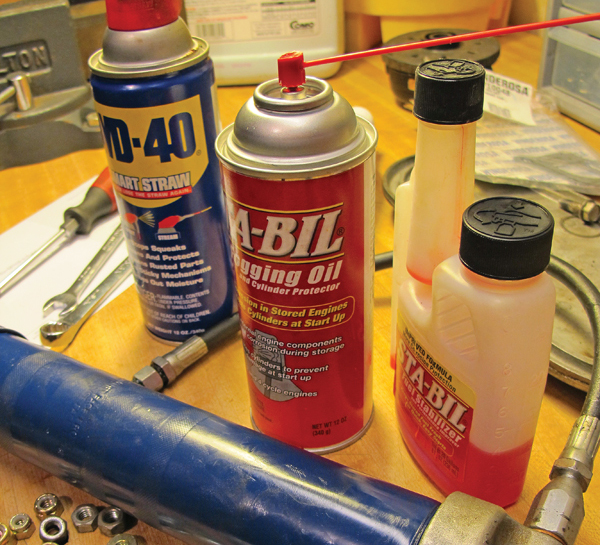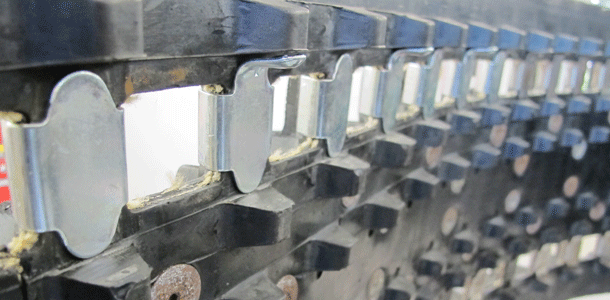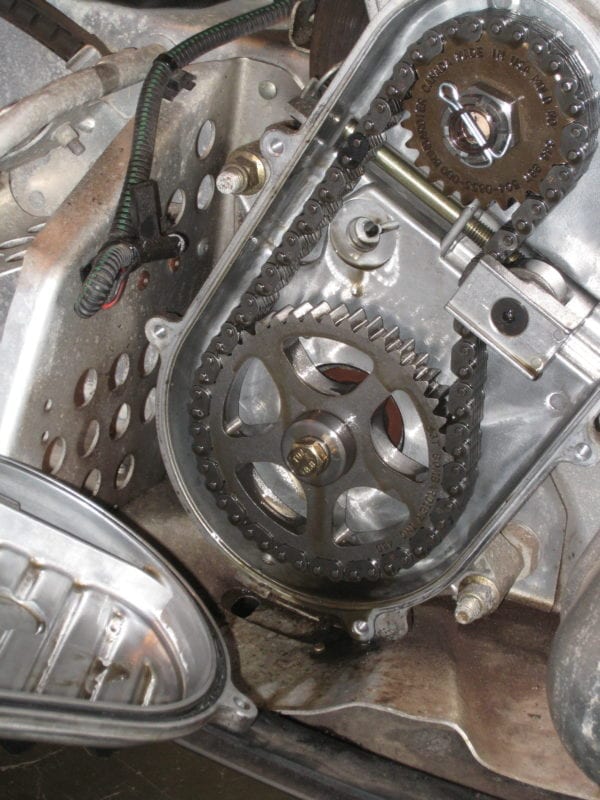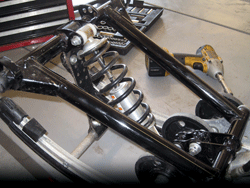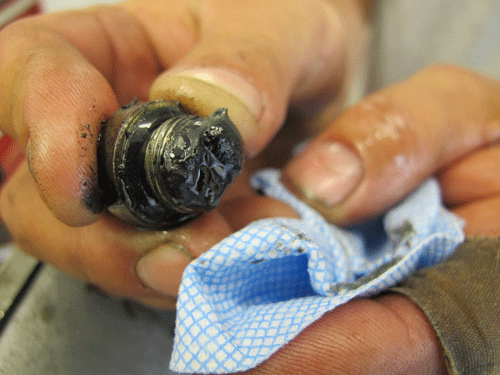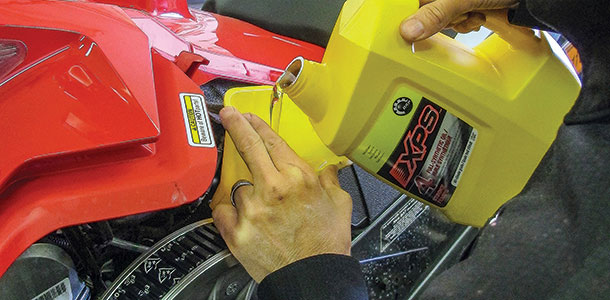Mr. Sledwrench can’t wait to take apart the seized engine, unbolt a twisted trailing arm or remove the shelled chaincase. Of course, he wouldn’t be able to do all of this work without the proper tools and equipment.
A garage that’s well-equipped and arranged with efficiency in mind can save sledders hundreds of dollars per year by enabling them to make repairs themselves rather than bring their sleds to a shop. For some people, the ultimate garage can help them earn extra money by repairing sleds for friends and family.
Who Are You?
The needs of every do-it-yourselfer vary, so the level to which a garage is equipped will also vary. Consider what types of repairs and modifications you’re likely to do and equip your shop as necessary.
Sledders whose skills or time constraints limit them to performing regular maintenance like track adjustments, ski alignments and grease jobs will need a relatively simple and inexpensive setup. Standard and metric wrench sets, a 3/8-inch drive socket set, slotted and phillips screwdrivers and several types of pliers should be adequate.
A tape measure is necessary for setting ski alignment and a grease gun will keep suspensions and steering systems working smoothly. It wouldn’t hurt to have a set of allen wrenches, too.
Snowmobilers who also stud tracks, rebuild clutches, repair suspensions and set up sleds for the mountains will need air tools, a compressor and some brand-specific specialty tools for clutch work.
An air-powered drill and an impact wrench make quick work of studding a track. Front and rear suspensions are held together with many tight fasteners and a thread-locking compound. An impact wrench will speed up the job and prevent bloody knuckles.
A workbench is a key component for any home-based shop. It’s where carburetors will be cleaned and clutch bushings will be replaced. Having a clean, spacious surface makes work easier and reduces the chance of parts getting lost.
When a garage and its mechanic becomes a place to heal sled woes of relatives and riding buddies, more equipment and better tools are necessary to perform a wider variety of services.
This expert is likely to rebuild engines, shocks and perhaps fix crashed sleds for profit. These people are also likely to repair more sleds than the average do-it-yourselfer, so a smartly arranged shop is important.
Special brand-specific tools are needed to remove flywheels, rebuild shocks and service clutches. The cost of this equipment can add up quickly, so the investment only makes sense for a person who does repairs regularly. These tools are usually only available from a dealer.
Magic Triangle
Many people turn sled repair into an aerobic exercise — crossing their garage countless times and stretching high and low to fetch tools and supplies — because their shop isn’t set up correctly. Proper arrangement of the snowmobile, tools, workbench and storage equipment positively affects how convenient a shop is to work in.
The snowmobile, tools and workbench should be within a few steps of each other — without a garbage can, jackstand or heap of snowmobile covers in the way.
Arrange the shop so the workbench is the main piece and arrange everything else around it. Hang a light directly above to make it easier to see tiny parts like jets and Jesus clips.
Because a lot of work will take place on the bench, the toolbox should be right next to it. Tools nearby make it easy to grab a needlenose pliers or pick during an oh-so-critical moment of a recoil repair.
The third point of the triangle is filled out by the sled. Reserve a spot a few feet in front of the bench to park it.
Air Tools
An air compressor and its tools are some of the handiest things to have in a shop. It speeds up work and provide much more power while using less energy than electric tools.
An impact wrench provides extra brute force to remove stubborn bolts like those that hold a drive clutch on a crankshaft. It speeds up the repair of components that have lots of fasteners, too.
For most jobs, a 3/8-inch drive impact wrench is adequate. It typically cranks out about 250 pound-feet of torque. For big bolts and nuts that are really stuck in place, a 1/2-inch drive wrench might be necessary; its torque ratings approach 500 pound-feet. Expect to pay between $100 and $300 for an impact wrench depending on brand, model and torque rating.
Several tool companies make cordless impact wrenches that work well to speed up repairs with lots of fasteners such as suspensions and engines. These are especially handy when air tools aren’t available.
Air ratchets are handy for quick disassembly of parts. Mechanics can just squeeze the trigger and let the tool do the work rather than twist their wrists back and forth to spin out a bolt.
Air ratchets are not intended to loosen seized bolts and nuts; that’s what impact wrenches are for. A 3/8-inch drive air ratchet provides about 90 pound-feet of torque. It works very well to remove clutch and chaincase covers. Air ratchets are especially preferred to impact wrenches when reinstalling clutch cover bolts to reduce risk of twisting off the head. A 3/8-inch drive air ratchet costs between $100 and $150.
Other air tools that are handy for snowmobile repairs include air chisels, grinders, drills and blowguns. Air chisels work well to remove rivets, seized jackshaft and driveshaft bearings and stubborn hyfax. Grinders are especially handy to cut bolts and clean up corroded metal.
Blowguns have many uses and only cost about $10. They’re a necessity for cleaning carburetors where gunk gets stuck in small passages. Run a sled through a patch of cattails? Compressed air will blow the seeds out of all the crevices. Belt dust on clutches is no match for them, either.
Air tools aren’t any good without a compressor that can keep up with a tool’s air volume requirements. When shopping for a compressor, make sure that its air delivery is more than the air requirements of the tools. This information is posted on the tools and compressors.
Many portable air compressors are adequate for a home mechanic’s needs. For example, a 2 hp, 30-gallon compressor might deliver 5.7 cubic feet per minute (CFM). Because most intermittently used tools such as an impact wrench use about 3.5 CFM at 90 pounds per square inch, that compressor would be adequate and would cost about $350.
Tools that are used continuously, such as grinders and sanders, need nearly twice as much air. The compressor listed above would power a grinder, but would run constantly to keep up with the tool’s demand.
Belt-driven compressors are generally longer-lasting with less vibration and noise than oil-less versions. Belt-driven compressors run cooler, too. Oil-free compressors are virtually maintenance free and designed for light-duty, occasional use. They cost less, too.
Another thing to consider is whether the compressor sits vertically or horizontally. Vertical compressors are usually stationary and occupy less floor space; they cost slightly more, though. Horizontal compressors are a better option when portability is key because they are less likely to tip over if hauled in the back of a pickup.
Other Considerations
Storage is another thing to plan. Oil jugs, drain pans, cleaners and awkward tools like a clutch press should be kept in a spot that’s easily accessible. A steel cabinet with doors that latch is ideal for this stuff because it hides clutter and offers some measure of fire prevention.
To make track studding easier, toss a rope or cargo strap over a rafter that’s above the sled’s parking spot; hold it in place with a slip knot. Use the strap to raise the rear end of the sled off the ground, then the poor sap who gets stuck with the job won’t be crouched inside the tunnel.
A sled lift is a must-have for people who work on sleds more than a few nights per week. A lift raises the sled to a comfortable work height so the mechanic doesn’t have to bend over to work under the hood.
Lifts range from about $250 to more than $1,000. Less expensive versions are made of square steel tubing and use a hand crank to raise and lower the machine. These lifts are adequate for most home mechanics.
Top-of-the-line lifts use air or electric power. They consist of a large steel deck that provides a spot to set tools or a drain pan and offer many optional accessories to accommodate ATVs, motorcycles and garden tractors.

